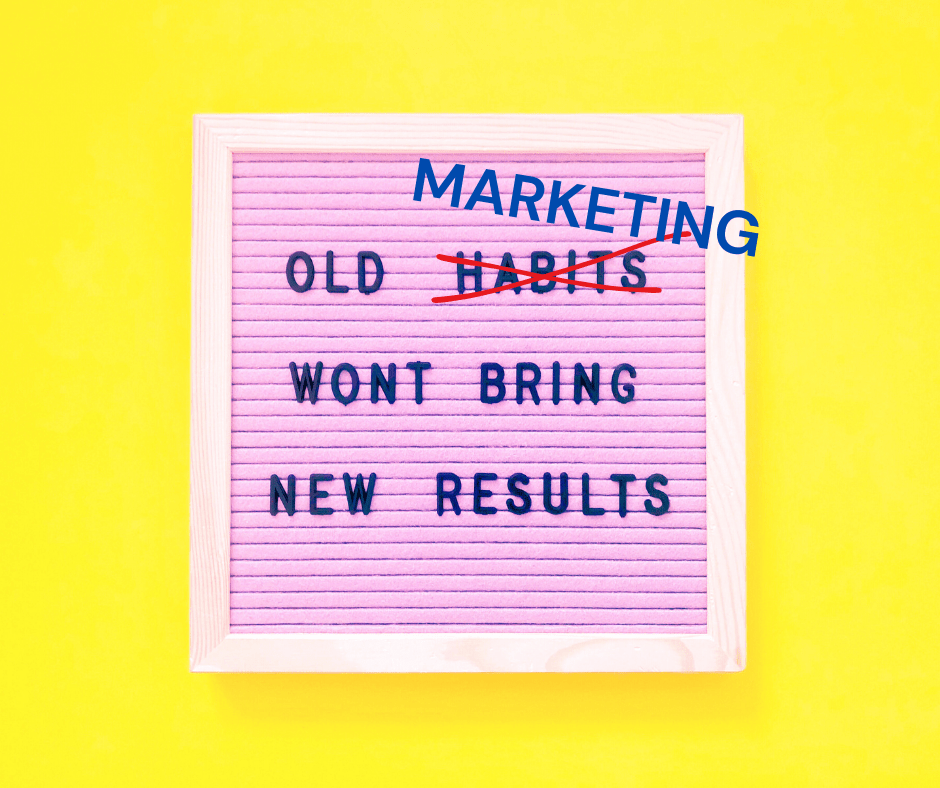- +1 512-591-8295
- [email protected]
- Mon - Fri: 9:00 - 16:00

But let’s get real for a moment. It’s not just that traditional marketing strategies are becoming stale; it’s that the marketing landscape itself is shifting beneath our feet.
Social media platforms are increasingly becoming pay-to-play arenas, demanding more investment for diminishing returns.
Organic reach is a relic of the past, and even paid ads are losing their luster as ad fatigue sets in.
And then there’s the elephant in the room: the transition from Search Engine Optimization (SEO) to Search Generative Experience (SGE) and other similar AI-based search such a Bing.

SGE is transforming the way we interact with search engines, moving beyond mere query responses to offer dynamic, personalized experiences. This shift is creating a new set of challenges for businesses, as traditional SEO tactics are no longer enough to capture user attention in this evolving digital landscape. Heck, your business may not even be positioned to appear on “page 1” of search results any longer.
So, what’s an entrepreneur to do when the rules of the game are not just changing but being completely rewritten?
That’s where this article comes in. We’re going beyond the beaten path to explore marketing strategies so disruptive, they could be your secret weapon in this evolving digital battleground. But don’t worry, some of the ideas are so simple that you’ll be able to implement them now. Others … well let’s just say some of the ideas are out of this world.
Forget what you know about traditional marketing; it’s time to redefine the game. And the best part? You don’t have to be a tech wizard or a millionaire to implement these strategies. Ready to revolutionize your marketing approach? Keep reading.
Use these to spark ideas about ways you can start to bolster your marketing. I’ve brainstormed a combination of things you can probably do now with the capabilities that you have on hand – some tried and true marketing strategies that are proven to still work – plus some more out-of-the box ideas that may take a bit more creativity to implement. Remember … there is no box 😉
Why It Works:
People are inundated with digital ads but receive fewer physical mailers, making them more memorable.
How to Implement:
There are even ways that you can increase consumer recall by making your direct mail more interactive to the touch, such as having fun ways to unfold and turn the mailer into something a bit different.
Why It Works:
People trust local businesses and community involvement creates strong word-of-mouth. This is a long-tested marketing strategy that continues to work.
How to Implement:

Keep in mind, big events, or big teams (like the one here!) may not be what’s right for your business. Consider local theater productions, school sports teams, area cultural event … places and events your audience already visits.
Why It Works:
People trust recommendations from friends and family more than any form of advertising.
How to Implement:
Why It Works:
It engages all five senses, creating a memorable brand experience. I’ve spoken about some of the psychological shopping signals before; and you can take this concept to a new level with your branding.
How to Implement:
Why It Works:
SMS has high open rates and allows for more personalized communication. Just be sure not to get spammy.
How to Implement using current strategies:

Here are some ways you can futurize your existing SMS strategies:
Why It Works:
It involves your audience in the creation process, building investment and anticipation.
How to Implement:
Why It Works:
It engages your audience in social good, creating a strong emotional connection.
How to Implement:
Why It Works:
Two heads are better than one. Partner with a non-competing business to expand your reach.
How to Implement:
Why It Works:
The scarcity and uniqueness create buzz and urgency.
How to Implement:
Why It Works:
It’s a spectacle that draws attention and encourages public interaction.
How to Implement:
Why It Works:
Send promotions or information to potential customers’ smartphones when they enter a specific geographical area.
How to Implement:

I’ve actually implemented this type of geofencing strategy for a client. Local coffee shop had an app that their customers were already using for loyalty rewards.
We implemented a geo-targeting strategy that triggered when they were near the shop but also close to a competitor’s coffee shop. The app would trigger a special message or discount offer that would pop up on their phone whenever they were in targeted areas.
This was a great reminder for the customer to pay a visit to their favorite coffee shop when they were in the area, instead of visiting the competitor, and noticeably increased foot traffic during the campaign.
Why It Works:
It’s high-impact and memorable, but without relying on social media for virality. I’m a huge fan of Guerilla Marketing strategies because we’ve seen them work when we have designed them for clients. You can read about some of the simple Guerilla Marketing strategies that we’ve implemented for clients in the past.

Why It Works:
People love to learn. Offering free workshops positions you as an expert, and while these strategies have been around for a while, you can add future elements.
How to Implement:
Why It Works:
Influencers have a ready audience but think beyond Instagram or YouTube. Microinfluencers and content influencers are accessible to most entrepreneurs.
How to Implement:
And here are some ways you can update these strategies:

Why It Works:
It’s advertising in unexpected places where people spend time.
How to Implement:
Why It Works:
It creates a memorable experience that people will share (offline).
How to Implement:
Why It Works:
It combines the real world with digital elements, creating a unique, immersive experience that can go viral offline.
How to Implement:
I told you that some of the ideas would be out of this world…

Let me quickly tell you about the image above. This is a SpaceDuck from Owl Integrations, who are making the world resilient through technology – connecting communities, empowering Individuals, and facilitating growth one network at a time. You can learn more about SpaceDucks at the video on their website … and meet my son Charlie on their About page. Oh, all you flat earthers, that earth looks a bit round to me… just sayin.
Why It Works:
It’s literally out of this world. Imagine your brand or message in space.
How to Implement:
Interested in space? You never know … I may be able to hook you up with a space-bound sponsorship.
Why It Works:
It brings the “in-store” experience to the customer, wherever they are.
How to Implement:
Why It Works:
It takes personalization to the next level by predicting what the customer wants before they even know it.
How to Implement:
Why It Works:
It’s not just about quick delivery; it’s about making that delivery an event.
How to Implement:
Why It Works:
It allows customers to “walk through” a store and browse products as they would in real life, but from the comfort of their home.
How to Implement:
We’re already using some VR in our marketing, at a basic level (which is what works for the entrepreneurs who don’t have unlimited budgets), check it on our Future of Marketing page.
Why It Works:
Imagine a Spotify or podcast ad that’s not just targeted to the listener’s demographic but is personalized to their current activity or mood.
How to Implement:
Why It Works:
Counterfeiting is a big issue in many industries. Blockchain can provide indisputable proof of authenticity.
How to Implement:
Why It Works:
It turns a traditional business card into an interactive experience, providing much more information and engagement than a piece of paper.
How to Implement:
I have a QR code on my business cards that pops open a VCard where the person can add all of my contact info to their phone by simply clicking a button. However, I’m also exploring adding a VR capability into this as well.
Why It Works:
As smart home devices become more prevalent, voice-activated promotions could be the coupons of the future.
How to Implement:
Why It Works:
The more people buy, the cheaper a product gets, encouraging social sharing and bulk buying.
How to Implement:
Why It Works:
Leverage wearable tech data to recommend products based on the user’s current mood or physical state.
How to Implement:
Why It Works:
It’s the ultimate in convenience, using machine learning to predict when a customer will need to reorder a product and doing it automatically. ECommerce platforms such as Chewy and Amazon sort of have this now, and it’s sure to become even more intelligent along the way.
How to Implement:
Some of these ideas are a bit more far out there than others which are already being used by some companies.
The takeaway here is that given everything I’m seeing on the marketing front, your same old strategies may become less and less effective.
It’s been a bit easy for a lot of companies to skate by, relying solely or primarily on social media while ignoring all other strategies, or social media and strong SEO which may not be so strong just a few months from now.
I always recommend to think of your marketing like a stool. Any stool with only one or two legs will never be as stable as one with three or four. If you’ve been relying solely or primarily on either of these marketing channels, you need to strategize quickly to get in front of the looming wave of marketing change.
Let's Generate Some Effective Ideas for Your Business
Entrepreneurs tend fall into one of two buckets:
Get solid marketing strategies, designed for entrepreneurs on the track to 7-figures and beyond, right in your inbox.

This website uses cookies to ensure you get the best experience on our website. By continuing to use the website, you agree to our use of cookies. We do not share or sell your information. More info
